What age is just right for marriage if you want the lowest chance of divorce? Turns out it’s late 20s to early 30s. Sociologist Nicholas Wolfinger explains,
I analyzed data collected between 2006 and 2010 from the National Survey of Family Growth (NSFG). The trick is to use statistical methods that permit nonlinear relationships to emerge (click here for more information on these methods). My data analysis shows that prior to age 32 or so, each additional year of age at marriage reduces the odds of divorce by 11 percent. However, after that the odds of divorce increase by 5 percent per year. The change in slopes is statistically significant. The graph below shows what the relationship between age at marriage and divorce looks like now. This is a big change. To the best of my knowledge, it’s only recently that thirty-something marriage started to incur a higher divorce risk. It appears to be a trend that’s gradually developed over the past twenty years: a study based on 2002 data observed that the divorce risk for people who married in their thirties was flattening out, rather than continuing to decline through that decade of life as it previously had.
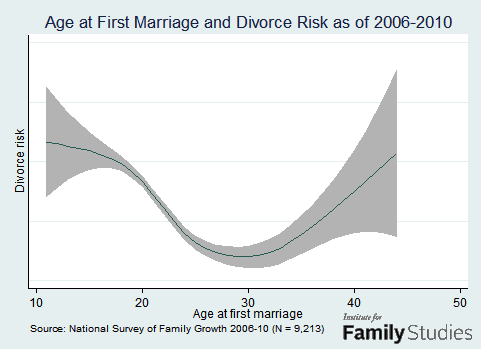
Why? Wolfinger suggests a selection effect:
[T]he kinds of people who wait till their thirties to get married may be the kinds of people who aren’t predisposed toward doing well in their marriages. For instance, some people seem to be congenitally cantankerous. Such people naturally have trouble with interpersonal relationships. Consequently they delay marriage, often because they can’t find anyone willing to marry them. When they do tie the knot, their marriages are automatically at high risk for divorce. More generally, perhaps people who marry later face a pool of potential spouses that has been winnowed down to exclude the individuals most predisposed to succeed at matrimony.
…Many people who delay marriage nowadays for financial reasons marry as soon as they feel they can afford it. These are the people who wed in their late twenties, the years of peak marital stability. The folks remaining in the pool of marriage-eligible singles are the kinds of people who aren’t well suited to succeed at matrimony (irrespective of their financial well-being).
…This is all conjecture. But we do know beyond a shadow of a doubt that people who marry in their thirties are now at greater risk of divorce than are people who wed in their late twenties. This is a new development. This finding changes the demographic landscape of divorce, and lends credence to scholars and pundits making the case for earlier marriage.
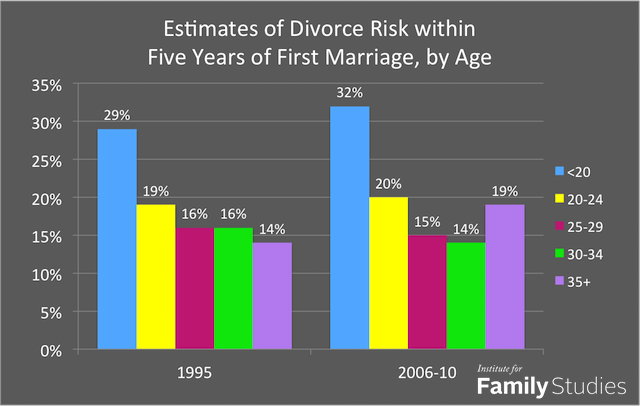
Can this be replicated? Wolfinger writes,
Replication is always crucial in the social sciences. I therefore sought to reproduce my findings with more recent data from the NSFG, the 2011-2013 survey (for details about my data analysis, click here). The primary result, depicted below, was almost identical to what I obtained from the 2006-2010 survey: the 28 to 32 age range remains the period of lowest divorce risk.
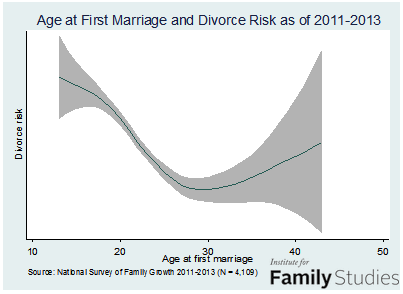
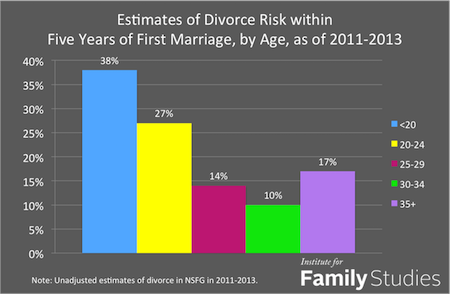
When Wolfinger “controlled for respondents’ sex, race, family structure of origin, age at the time of the survey, education, religious tradition, religious attendance, and sexual history, as well as whether the respondent had a child prior to wedlock, and the size of the metropolitan area that they live in,” there was “a gentler increase in divorce risk for people marrying after their early thirties.”
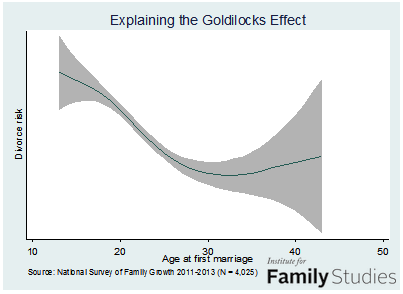
He concludes, “I have now shown the Goldilocks effect using two different data sets, the 2006-2010 and the 2011-2013 National Surveys of Family Growth, and more than 10,000 respondents. Its existence is beyond question. Explaining the Goldilocks effect, however, will require additional scholarship.”